Part 3: Organisational health and capability
We need a strong foundation of skilled people working together in a well-run organisation to ensure that we can achieve our outcomes, impacts, and outputs.
Our people
We will continue to recruit a number of new staff each year. Some of these will be experienced professionals – replacing those who have left us – but we also hire a number of accounting graduates. We expect to see our staff develop both their vocational and leadership expertise, strengthening their contribution to the Office and the public sector. We will continue our focus on each individual's needs in developing skills identified in our competency frameworks, on our leadership development programmes, and on improving the level of engagement of our people (as measured by our annual staff engagement survey).
Historically, our highest area of staff attrition is in recently qualified accountants. The global and local economic downturn resulted in a reduced turnover of staff in 2009/10. However, as expected, attrition since then has returned to pre-recession levels.
Equal employment opportunities
The Office's equal employment opportunities programme is embedded in our recruitment and employment policies. Our recruitment programme aims to attract and appoint the best people, who have the appropriate skills, values, and attributes to meet the Office's needs, objectives, and strategic direction. We recruit in a manner that provides equal employment opportunity to Māori, women, ethnic or minority groups, and people with disabilities.
Recruitment and employment decisions and practices (such as feedback from exit interviews) are monitored to confirm application of policies. Managers are made aware of, and given support to fulfil, our good employer obligations through specific programmes, courses, and one-on-one coaching.
Our staff profile in Figure 41 shows staff numbers and staff diversity from 2010 to 2012. Increases in staff numbers in both the Office of the Auditor-General and Corporate Services over this period have resulted from the increased demand for specialist support roles and pressure on core business activities.
Figure 41
Staff profile
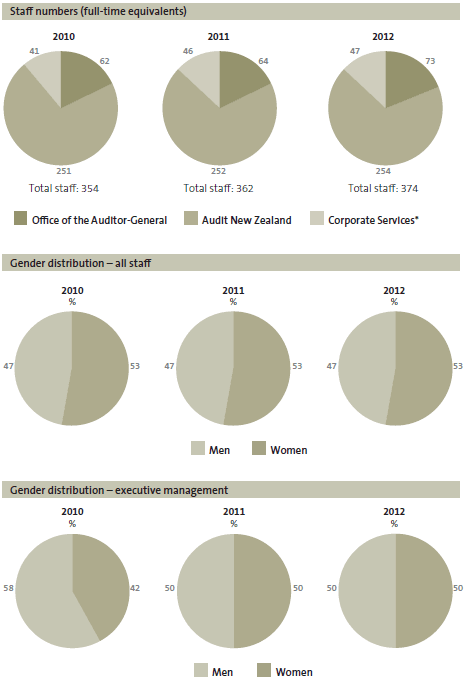
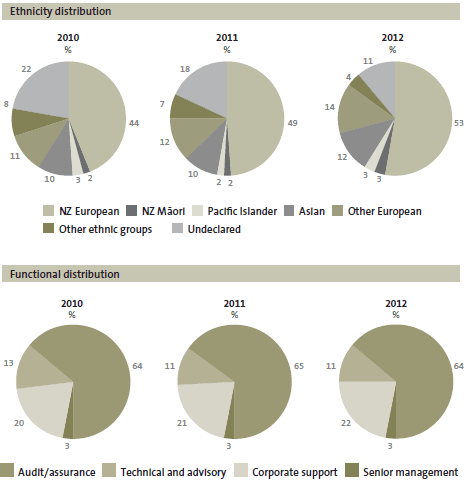
* Corporate Services function is shared between the OAG and Audit New Zealand.
Our performance in 2011/12
Business practices
In 2011/12, we carried out an effectiveness and efficiency self-assessment of some of our corporate functions. The "Better Administrative and Support Services" (BASS) benchmark results indicate that our corporate costs are slightly less than the average in the BASS cohort, and that our effectiveness – as measured by BASS's Management Practice Indicators – is broadly consistent with the cohort.
Facilities
This year, we made very good progress on addressing our long-term property needs in Wellington and Auckland. Although we are pursuing some options, we have not yet found a satisfactory solution for our Christchurch staff.
The Office received additional capital funds in 2011/12 to fit out replacement premises for our staff in Wellington, allowing us to consolidate all Wellington staff into one location. We subsequently entered into an agreement to lease space at a fully refurbished 100 Molesworth Street. At the end of the 2011/12 year, the refurbishment is well advanced and we expect to complete the relocation of all staff by the end of the 2012/13 year.
At the end of 2011/12, the lease on our Auckland premises expired. Following an extensive procurement process, we entered into a lease for newly refurbished premises, and staff were successfully relocated in July 2012.
Since the Canterbury earthquakes, our Christchurch staff have been working from temporary premises. Although these premises meet basic requirements, the effectiveness and efficiency of our people has been affected. We have been searching unsuccessfully for replacement premises over the 2011/12 year, and we are hopeful that we will locate appropriate premises in the 2012/13 year.
Information systems
We rely on information technology to do our work. To ensure an effective, efficient, and customer-focused service, our audit staff working in the field use specialist auditing and remote access and communications tools which presents us with significant logistical issues. This year we developed further enhancements to one of the most important tools we use to help manage these logistical issues – the Audit Status Database (ASD), which we built in-house. It contains our authoritative source information about the almost 4000 public entities we audit, and also includes information about auditors, audits, and audit contracts.
In 2011/12, we selected a partner to work with us on implementing an Enterprise Content Management system (ECM) that allows the collection, storing, analysis, sharing, reuse, and reporting of the information the Auditor-General and her staff and Appointed Auditors collect during the course of their work. We recognise the significant value this information and insight could bring to improving the performance of the public sector, and we are keen to make the collection, analysis, and use of this information and insight as effective and efficient as we can.
In 2011/12, we also initiated projects to upgrade our end-user desktop environment including the audit support tool used by our auditors, and enhanced the functionality of our audit tracking systems.
Audit New Zealand
Our audit staff have consistently performed well in the New Zealand Institute of Chartered Accountants (NZICA) accreditation examinations. This year a very pleasing 97% pass rate was achieved by staff who sat these examinations, ensuring that we again met our 95% target.
Our targets for client survey results were not maintained this year, and showed some small decreases in ratings. We are committed to improving these results and ensuring that our clients are confident that we understand their business and operating context.
This year's results for the New Zealand Institute of Chartered Accountants (NZICA) practice review of Audit New Zealand were pleasing. The NZICA review considered that Audit New Zealand has:
- nationwide audit and assurance methodology;
- quality assurance procedures;
- quality control programmes; and
- procedures that comply with NZICA's professional, ethical, quality control standards and the Auditor-General's auditing standards.
Participation in the practice review is voluntary for Audit New Zealand because its NZICA members employed by the Auditor-General do not offer accounting services to the public.

Figure 42
Summary of measures and standards for organisational health and capability
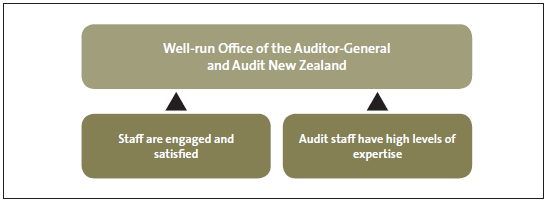
Staff are engaged and satisfied
| Measure: | Improve (or at least maintain) the engagement and satisfaction of our staff measured against the previous two years. |
| Comment: | The Office's staff engagement survey is based on responses to statements on a 5-point scale, with "1" being the lowest score and "5" being the highest. |
| Result: | Partially achieved. Our survey results saw slight improvements in overall engagement (3.84) and teamwork (3.72). We maintained results in overall satisfaction (3.63), basic needs met ( 3.93), management support (3.65), and growth (4.04). |
Figure 43
Staff engagement survey scores
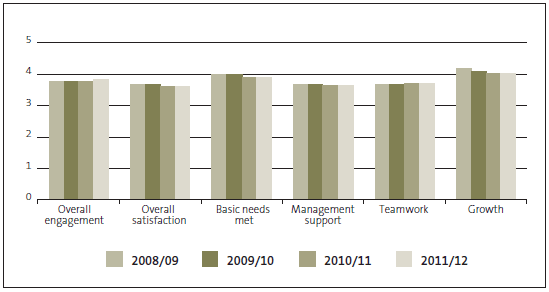
| Measure: | Improve (or at least maintain) the average years of experience of our staff measured against the previous two years. |
| Result: | Achieved for Audit New Zealand (5.5 years) and Corporate Services (4.5 years). Not achieved for OAG (6.4 years). |
Figure 44
Average number of years that staff have been employed by the Office
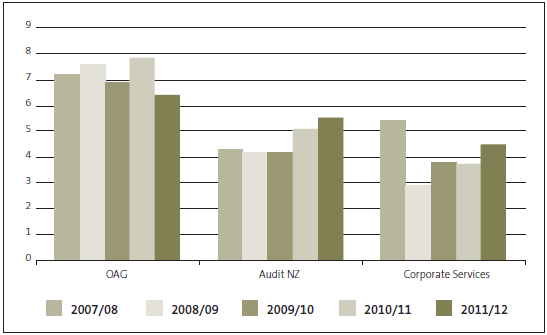
| Measure: | Staff turnover – no target set. |
| Comment: | We have previously reported turnover information in the staff profile section. However, we consider that a more appropriate place is here, under Staff are engaged and satisfied. Turnover is influenced by the New Zealand economy, and by the worldwide demand for qualified auditors. Following the global financial crisis, our turnover dropped to 10%, but in the last two years it has returned to more normal levels. Overall we are comfortable with a turnover of up to 20%, but would prefer no more than 15%. |
| Result: | Staff turnover results: OAG 21%, Audit NZ 21%, Corporate Services 14%. |
Figure 45
Annual turnover of staff
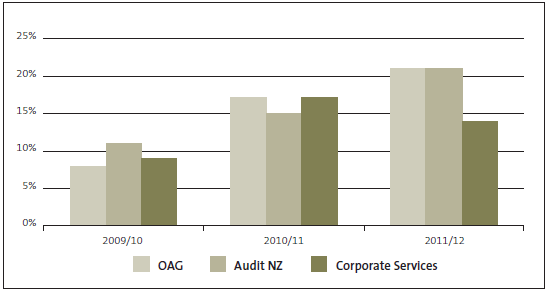
Audit staff have high levels of expertise
| Measure: | Achieve a pass rate of staff undertaking accreditation examinations of not less than 95%. |
| Result: | Achieved. 97% pass rate for staff sitting accreditation examinations. |
Figure 46
Percentage of audit staff passing NZICA accreditation examinations
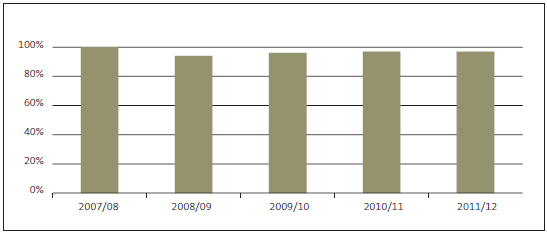
| Measure: | Client survey feedback shows that auditors' knowledge of entities' business and operating context is improving, and that auditors are investing in work to understand that context. Our clients give us improved (or at least maintained) ratings (on a scale of 0 to 10) compared with the previous two years for their auditors':
|
| Result: | Not achieved. Our clients' ratings were not maintained. Understand business and risks 7.3, General skills and knowledge 7.2, Information to improve 6.4. |
Figure 47
Ratings for expertise of Audit New Zealand staff
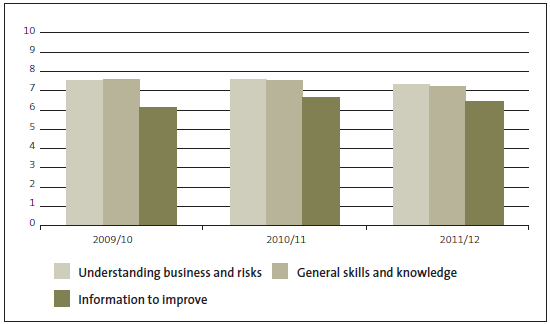
Audit staff have high levels of expertise: Auditing performance information
| Measure: | Our quality assurance reviews of our audit and assurance work confirms that auditors are carrying out the requirements of AG-4 (Revised). |
| Comment: | AG-4 (Revised) is the Auditor-General's revised auditing standard on auditing non-financial performance information. |
| Results: | Achieved. Quality assurance reviews of our audit and assurance work confirmed that auditors are carrying out the requirements of AG-4 (Revised). |
| Comment: | The reviews have identified some areas where the audit of this information could be improved in future. |

